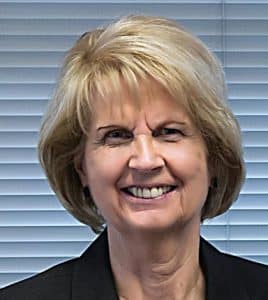New group energizing economic development

Edie Koch
If anyone claims they can spend an hour with Edie Koch, the new executive director of the Monroe County Economic Development Corporation, and not come away excited, they are just plain wrong.
She has a strong vision for the county’s economic future. She understands the way ahead, and she is driving hard to get there.
The Republic-Times sat with Koch and corporation chairman Jim Hill at the courthouse on Monday, and certainly came away excited. The corporation’s message, “Regionally Focused, Globally Competitive,” says much.
Koch started by stating the group’s mission.
“The Monroe County Economic Development Corporation is a public-private partnership incorporated to pursue a more diversified local economy, a broader tax base, and an enhanced quality of life through recruiting new businesses, encouraging innovation, and supporting the retention/expansion of existing businesses,” she detailed.
Koch brings a solid track record supporting her methods of achieving success. Perhaps most telling are results of an 11-year engagement in the nine-county Southwestern Illinois Regional Economic Office, during which she spearheaded $4.8 billion in business investments while growing or retaining some 7,000 jobs.
Koch and Hill acknowledged the remarkable work done by the late Nora Feuquay in heading the county’s economic development council. She offered her business acumen to local businesses and oversaw a successful series of small business seed money loans.
But they also cited how something has kept Monroe County separated from much economic growth in the region.
“Monroe County is a great place to live,” Koch said.
A population growth of approximately 500 new citizens per year – 11,600 since 1990 to an estimated 34,000-plus today – confirms that. But large numbers of new jobs, high-paying professional and skilled trade jobs and careers, have not developed locally or come here in sufficient numbers.
When the county’s young people finish high school, they go away to college or skills training, and many do not return. Job opportunities are simply better elsewhere.
Koch and Hill noted the new CEO business program in local schools, which is introducing students to the business world in an very up-close and comprehensive manner, as part of the hope for positive change.
“If you look at a map of the St. Louis region and place dots where new businesses are locating, there is a glaring wedge with very few dots. It’s Monroe County,” Hill said.
That offers opportunity, Hill and Koch agreed.
“But we need a public-private partnership to do this,” Koch noted.
Among early steps being taken by the corporation, Koch said she is slating visits to existing businesses in the region.
“We need to be mindful of retaining what we have,” she said. “Information gathered from the visits will be analyzed and brought back to the corporation’s business retention and attraction committee. Members will find ways to address any issues that may emerge and engage the appropriate resources to help stimulate growth.
“We also have to identify developable property – ‘deal ready’ property, if you will,” she emphasized. “Businesses that might consider locating here need to know the property is ready for them, that there are or can be in time, utilities like gas, water and electricity. Then we have to market those opportunities.”
Goals call for bringing light industry, warehousing and distribution centers, and corporate or regional offices here.
Koch cited the opportunity of the Route 3 corridor as an example.
“There is so much untapped potential for development there. The corporation definitely will want to get involved in that initiative. That can become an even stronger economic engine,” she said.
There and elsewhere, such entities as business or industrial parks are the smart way to grow.
“We have to bring government into business attraction and growth, with measures including tax incentives. We have to develop local incentives to be competitive,” Koch said.
The first words of the corporation’s message – “regionally focused” — tell an important story as well.
“We cannot confine our effort strictly to the county’s map boundaries,” Koch said. “We have to seek to cooperate and blur boundaries.”
And that means recognizing Monroe County is part of the 2.5 million citizens of the metro-St. Louis region, all within one hour of here. The county’s a small part population-wise, but a potentially attractive part.
Another example cited by Koch is attracting small, high-tech entrepreneurships.
“They exist in St. Louis and surrounding areas. As a one-person business looks at adding a second person, it needs a place to locate. It needs to be a place ready to move into, that offers good infrastructure, including communication. What better place could there be than an empty storefront? And who knows where the next firm like the developer of the square credit card reader is today? He or she is out there, somewhere,” Koch told.
Concerning being “globally competitive,” Koch acknowledged there are challenges to being noticed for development by companies overseas. The corporation is taking steps to partner with other regional entities and the state’s trade office to gain more exposure and prospect opportunities on the international front.
“It can be done,” she said. “Just look at the recent announcement of an Australian company bringing jobs and solving an environmental challenge by locating to the Baldwin power plant site.”
A couple of weeks ago, while presenting a certificate of appreciation to retiring Monroe County Board Chairman Terry Liefer, Koch told the board that 13 area entities, including local governments and businesses, have committed financially to the corporation. People are taking financial ownership of their collective futures together.
Growth is inevitable. Again, Monroe County is a great place to live, with good schools, recreation opportunities, shopping and pleasant places to live. But to date, it lacks the parallel business growth that will relieve much of the tax burden that has grown in the last 25 years.
We are not going to get there without intelligent, cooperative planning, Koch said.
But Koch hinted that there are successes in the offing.
“I have to agree to confidentiality to gain interest and then hopefully commitment,” Koch said. “But we hope to have some good news coming here soon.”
Is there a future Monroe County with a population of 70,000 or 100,000? In all likelihood, there is, and it is probably closer than we may think.
Will it retain all the good ingredients that are the quality of life here — with high-paying jobs to keep our children here or bring them back home?
That’s exactly what the Monroe County Economic Development Corporation is striving for.






